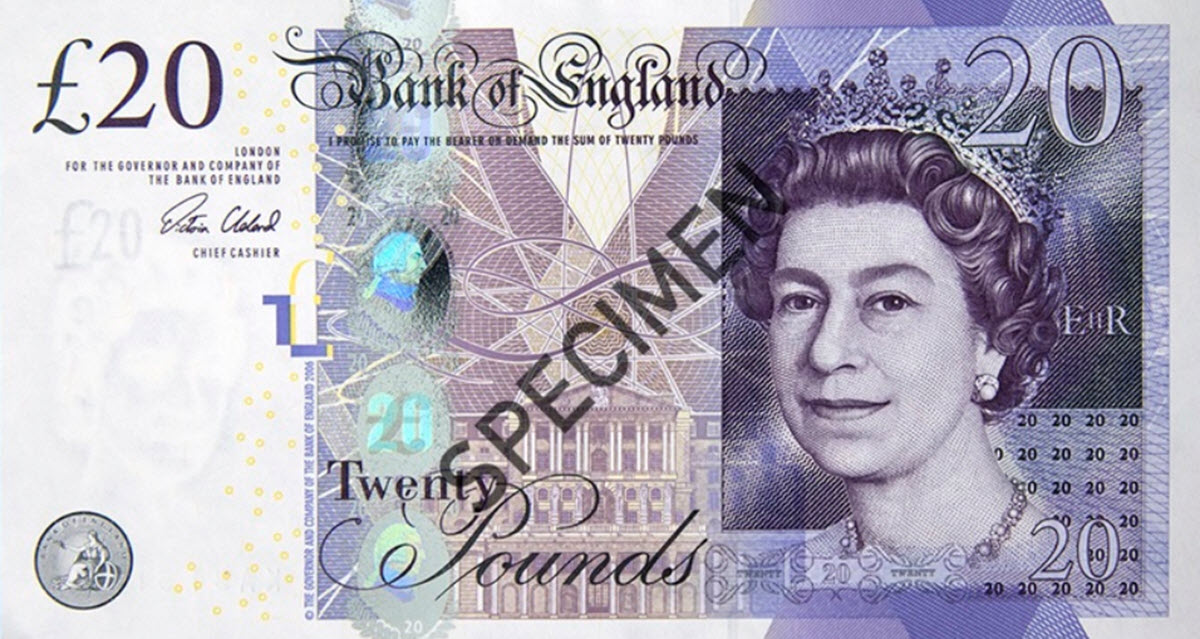The pound sterling is the official currency of the United Kingdom, Jersey, Guernsey, Isle of Man, the British Antarctic Territory, South Georgia and the South Sandwich Islands, and Tristan da Cunha. It is the oldest currency in the world that is both still in use and has been in continuous use since its inception.
1 pound sterling consists of 100 pence. (Singular penny, plural pence.)
On the global forex market, the pound sterling is the fourth most traded currency by value.
Most traded currencies by value (April 2016):
| Rank | Currency | % of daily trades (bought or sold) in April 2016 |
| 1 | United States dollar | 87.6% |
| 2 | Euro | 31.4% |
| 3 | Japanese yen | 21.6% |
| 4 | Pound sterling | 12.8% |
| 5 | Australian dollar | 6.9% |
Among forex traders, the exchange rate of the pound sterling against the US dollar is known as cable, because in the later 19th century, information about this rate was transmitted through the newly laid transatlantic telegraph cable. Forex traders of GBP/USD are still referred to as “cable dealers”.
The basics

Code: GBP
Sign: £
1 pound sterling consists of 100 pence (p).
Most frequently used banknotes: £5 / £10 / £20 / £50
Most frequently used coins: 1p / 2p / 5p / 10p / 20p / 50p / £1 / £2
Central bank: Bank of England
Printers:
- Bank of England for English (including Wales) notes
- Bank of Scotland, Royal Bank of Scotland, and Clydesdale Bank for Scottish notes
- Danske Bank, First Trust Bank, Ulster Bank, and Bank of Ireland for Northern Irish notes
- Crown dependency notes are printed by the States of Guernsey, States of Jersey, and the Isle of Man Government, respectively
The name
The full official name pound sterling is used in formal situations and when there is a need to distinguish this currency from other currencies named pound, such as the Egyptian pound and Sudanese pound. In everday situations, simply saying pound is much more common, although traders on the financial markets tend to say sterling instead, e.g. “Payment is accepted in sterling”. When stocks are traded in pence, the term pence sterling (GBX or GBp) is used to distinguish it from other currencies.
The name British pound is sometimes used in very informal contexts, but it is not the official name of the currency.
Around the world
The Bank of England is the central bank for the pound sterling. In addition to issuing its own coins and banknotes, it regulates the issuing of banknotes by private banks in Scotland and Northern Ireland.
The pound sterling is the official currency of the United Kingdom, Jersey, Guernsey, Isle of Man, the British Antarctic Territory, South Georgia and the South Sandwich Islands, and Tristan da Cunha.
The British Crown dependencies Jersey, Guernsey, and Isle of Man produce their own local issues of sterling: the Jersey pound, the Guernsey pound, and the Manx pound. Within their respective regions, these locally issued money is considered fully equivalent to sterling issued in the United Kingdom.
In the British Overseas Territory Gibraltar, Bank of England banknotes are legal tender alongside the locally printed and coined Gibraltar pound (GIP). The GIP is pegged to the pound sterling at par value.

History
Origins of the GBP: King Offa of Mercia
The origins of the pound sterling in England can be found in the 8th century CE, when King Offa of Mercia (who ruled the Anglo-Saxong kingdom Mercia from 757 to 796) introduced a silver penny inspired by the denarius, a coin used in Charlemagne’s currency system for the Frankish Empire.
The name sterling
Several explanations have been suggested for the origin of the word sterling. Here are the two dominant ones:
- Sterling is derived from steorra, the Old English word for star. The suffix -ling is a diminutive suffix, so sterling means “little star”, and the name was used for a silver penny used by the English Normans. 240 “little stars” could be minted from a pound of silver, so large payments were made in “pounds of sterling”.
- The Hanseatic League of the Middle Ages minted their own money, which – unlike the currency of England – wasn’t debased frequently. English traders therefore prefered the Hanseatic currency and required payment in pounds of the Easterlings. The Easterlings = The Hanseatic League, because of their strong association with the Baltic Sea, i.e. the East Sea. The Hanseatic office in London was for instance known as Easterlings Hall or Easterlingehalle.
This article was last updated on: February 15, 2024
